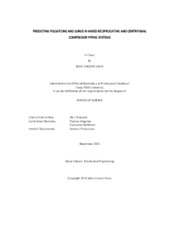| dc.description.abstract | The purpose of this work is to develop a method for modelling centrifugal compressor surge in the presence of pressure pulsations in gas transmission lines, and examine the effects of pulsation amplitude and frequency on centrifugal compressor operating stability. Anecdotal field evidence suggests that it is possible for a centrifugal compressor to enter surge when pressure pulsations are present, even in the case where the centrifugal compressor would otherwise operate at a stable point. In such a situation it has been concluded that the instability results from the pulsations.
The method used for the model of the piping system is a finite element model of the pipe acoustics, with a reciprocating compressor model and a centrifugal compressor model as boundary conditions. The details of these models and the methods for coupling them are a large portion of this work. The combined centrifugal compressor and piping acoustic model are used in a variety of numerical experiments investigating the effect of pulsation amplitude and frequency on the operating point of the centrifugal compressor.
The results of the numerical experiments show that piping system acoustic properties have a strong effect on pulsation amplitude, and pulsations have a strong effect on compressor operating point. The pulsations cause an oscillation in operating point away from the compressor’s steady state operating point. The effect is stronger as pulsation amplitude increases and as pulsation frequency approaches the natural frequency of the piping system. If the pulsations are strong enough, they can force the centrifugal compressor operating point over the surge limit, and then back into the stable operating region before the compressor enters a surge cycle. Numerical experiments show that the pulsations must push the centrifugal compressor over the surge limit and remain there long enough, if a surge cycle is to develop. Therefore, it is concluded that pulsations can cause a centrifugal compressor to cross the surge limit, and that larger pulsations will indeed cause surge when the operating point is across the surge limit for long enough. | en |


